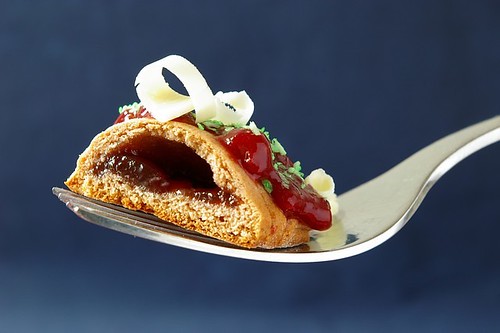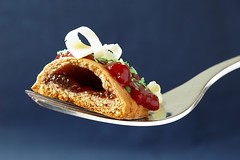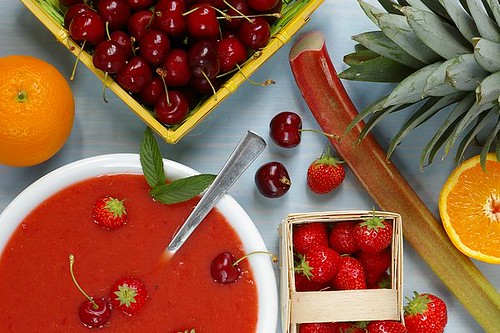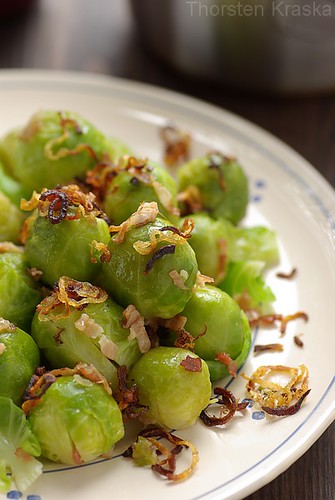
© All rights reserved, Thorsten Kraska, 2010
... a personal view on close up shots in Food Photography.
The question is how close should I get in my shooting to the food and not how close can I get in food photography. A close up in food photography is not a question of the technical limitations but a question of composition and content. Sometimes it seems that photographers like to get as close as possible (technically) to the food and not even thinking about a wider setting (what is the best way to make the food look appealing).
Maybe I should explain first what I mean with close up. For me a close up is a setting where only small part of the whole food/dish is shown OR where the food take most of the area in the photo, so that there is almost no background or empty space to be seen. An extreme close up would be a macro, where only details of the food are shown.
A look into food magazines
I read (monthly) food magazines for quite some time. And most of the photos presenting the food are not close ups. Most shots are done with a wider setting, presenting not only the food, but also plates, tableware, proppings and other stuff. And in my opinion there is a reason for it: the background is important for the mood of a photo. A table setting can be stylish, casual, formal, rustic, sunny or related to other impressions. And often it is that feeling the setting is creating which makes us want to make the recipe or what is more important (for them) to buy the magazine.
Close ups are used when the food is very stylish or the styling is important, but in many of these closer settings you still have "space" around the food/dish. Close ups are also used for ingredients, when they are presented alone (often against a sheer white background).
What is the difference between close up and wide setting?
No, I don't mean the distance to the food. What I mean is the difference in the compositional idea. With getting closer to the food you do two things: (1) you reduce background information, so that the space around the food is getting smaller and (2) you concentrate more and more on the food and its details.
(1)The space around the food, the background or whatevery you would like to call it has an important role in food photography. It is making the environment with all the different aspects of tableware, proppings, background and backdrop styling, or colors used. In a wide setting the food is the major element in the composition BUT not the only one. And with the other elements you can create atmosphere and mood which is influencing our perception of the food.

© All rights reserved, Thorsten Kraska, 2010
In this photo for "English Breakfast Muffins" two elements explain what the food on its own couldn't do. The newspaper stands for breakfast, because it is that time of day, when many of us read the news. And the tableware withits ornaments are standing for typical (or what we think is typical) English tableware. The orange marmelade does the rest. In a close up on the muffins you would have had a hard time to transport this message. As closer you get as more you loose this compositional idea.
(2) As closer you get as more and more you are relying on the food's own fascination. And every little detail of the food is getting more and more important. When in a wider setting a "spot" on the food can easily be overseen, it will jump into your eye when you get close. And as closer you will get as more the shown detail has to speak for the whole food/dish and has to represent it in an appealing way. In one word, it has to be PERFECT.
Perfection
Perfection is what makes a close up really difficult. You have to capture that one thing that makes your food look beautiful, the thing that makes other say wow. In a wide setting every element is "small" and so the small spot might not even get noticed, but in a close up every element is "big" and so the small spot will turn into a big one, a distracting one.

The photo at the beginning of this post is a good example. I think it is a good close up, not perfect maybe, but in my opinion I came as close as possible to what I have in mind. There is no obvious distracting spot to be seen and this single cookie is a good "summary" for the whole food. The sauce on top has a nice texture and the white chocolate makes a nice curl. There are no distracting crumbs on the cut through. But what is most important: although this photo is old (it was taken in 2006) I still like it. Yes, that's a main point: I still like it.

© All rights reserved, Thorsten Kraska, 2010
It is completely different for this close up. This is one of my close up shots which is NOT good. But a good example to explain why. It was made for an "Anchovy and Caper Vinaigrette" that's why there are some lettuce leaves. The lower left corner with the leaf is too dark, it would have neede an additional fill light. And in this close up you don't get what the food is all about. The surface of the vinaigrtee is nit very attractive in this close up and the bits of anchovy and caper are hard to recognize. With that angle the color of the vinaigrette is not well defined. OK, one could say a vinaigrette is hard to photograph. But I would say, if you can't do it right, why do it at all. Think of a different way to do it. When I would do it now, I would go most likely with a wider setting to include what this vinaigrette is for. Salad stands for freshnes, for a light dish (I would try to include that). This vinaigrette seems typical for mediterranean food. I would try to include that. It would be a different approach: this close up tries to focus on the food/recipe no matter what. Now I would try a different approach: do not focus completely on the food but try to transport the idea of a mediterranean salad with a wonderful vinaigrette on a sunny day. I'm not sure how wide in my setting I would get here, but the next example could present a first idea for this one too:

© All rights reserved, Thorsten Kraska, 2010
This setting is much wider as the one before, but this could also stand for the vinaigrette.
A suggestion
I know close ups are fascinating, especially when they are professional. But they have to be well done to reach the viewer. A small mistake can turn into a big one and the food sin't appealing any more. Before you get closer and closer to the food think about, if that is the way to show the food from its best side.
Examples
Two examples from my older shots (both were taken in 2006).

© All rights reserved, Thorsten Kraska, 2010
Although this is close to the food (the spoon with the pudding on it), the leveled angle gave me the chance to include the dish in the background which let it appear not as close as it was. According to my own explanation above, this one wouldn't be a close up. But from the perspective here it seems very close (and technically it was very close, because it was very close to the minimal distannce of the lens used here). I still like this one for its color and the texture of the pudding on the spoon: it has a nice texture, smooth but not runny. This photo is an example for what I said above: perfection. The spoon was the first element I brought in, mounted and fixed in this position. Then I did the lighting so that the reflections on the spoon were just right for me. I placed the glass with the pudding in the back so that it is behind the handle of the spoon. After all these arrangements were done I dripped on the pudding very carefully, so that it looked "nice" in my opinion. I did this not once, I did it several times. As soon as the pudding was on I did an exposure series.

© All rights reserved, Thorsten Kraska, 2010
A close up of the fruit soup couldn't shown the all the different fruit which are in the soup. The wide setting was perfect to disply them on the side of the soup and it gave me the chance to play around with the different elements in this composition.
The next two examples are using the same object (brussel sprouts) and again one close up setting and one wide setting.

© All rights reserved, Thorsten Kraska, 2010
This close up is working on two details which are not only representing the food, but also make this recipe for me. (1) The popping green color of the brussel sprouts which stand for freshness and the crispyness of the sprouts. The shimmer on them let appear them juicy. (2) The crispy browned onions rings. The taste of the brussel sprouts is so enhanced by browned onion rings. In a wider setting I couldn't have focus more on these two details. I would have lost the onions rings, because they would appear too small.

© All rights reserved, Thorsten Kraska, 2010
I choose a wide setting here. Getting closer here would have mean that I would focus more on details, but there are no details which are important to get the "idea" of this recipe. I include it in this post after the comment made by Wizzy about propping in wide setting. A wide setting doesn't need automatically more proppings. Beside the bowl the food is presented in, there is just a spoon and a place mat. The grey backdrop is a paper board. Such proppings like spoon, napkins, place mats, glasses, bowls are at hand. Even if you don't have many different ones, you can combine them in different ways.
If you like this post, you might also like:




7 comments:
A well written article, perfect for beginners like me. The example of the vinaigrtee is something I needed as I often have trouble clicking pictures of such things.
Thanks!
Sunshinemom, thanks for the feedback. Hope you find it useful as an opinion about close ups.
I just have to say that you are a master in the wider shots specifically Thorsten. I always enjoy looking at them. That is not to say that your closeup shots are not good... :) Great article and a very clear explanation on the do's and don't!
Thanks Simone. I tend to prefer the wider shots. So I thought I post my view about close ups.
Interesting conversation on close ups Thorsten. I have to agree with what you are saying and I admire how you compose to tell a story with your photos. This is difficult for me because I lack props. As a result I often find myself shooting closer as it is less expensive than having to purchase props.I am trying to purchase interesting props so that I can stretch myself but it can be expensive so it's going rather slowly
Thanks Wizzy for the comment. After your comment I have added two more photos. In the last one I have added a wide setting with just a few props and with props you will have at hand. I'm working with a limited set of proppings too, but that can be part of the challenge. To combine them differently.
the last two shots illustrate your point perfectly. Thanks for including them in this discussion
Post a Comment